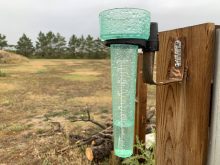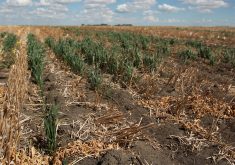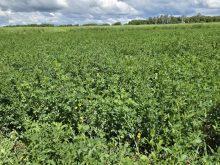Researchers at the Donald Danforth Plant Science Center in Missouri are seeking to bridge the gap between laboratory and field studies of crop-microbe relationships and their influence on drought tolerance.
“Lab and field studies both have advantages and disadvantages,” said scientist Rebecca Bart. “The goal of this research was to combine multiple different experimental systems to span the lab-to-field gap to capitalize on the strengths of both approaches.”
Microbes that occur naturally in agricultural fields can dramatically affect plant health. Over the past five years, Bart’s team focused on several different types of bacteria that affect root growth and development.
Read Also

Why feds imposed EV tariffs
Moe and Kinew have a fight on their hands when it comes to eliminating the EV tariff. Canada has to worry about pissing off the U.S. and Mexico and hundreds of thousands of auto workers.
“We observed that some bacteria hindered root growth, and this caused the plants to be more sensitive to drought. In contrast, other bacteria were able to protect the plant from the harmful bacteria and render the plant more tolerant to drought stress.”
They took a systems-level approach to identify microbes that affected drought response in sorghum.
By combining large, complex datasets from collaborators across several institutions, they were able to use computer models to understand the variations in the field.
The result was a first-of-its-kind statistical model that accounted for soil properties that influenced traits in both crops and microbes. This allowed them to compare their results between the lab and the field without wondering if environmental variations would alter the outcome of their observations.
The contributing institutions included University of Nebraska-Lincoln, Iowa State University, Washington State University, Colorado State University, University of North Carolina-Chapel Hill, and the Joint Genome Institute.
They compared sterile, controlled environments in their science lab with field experiments in agricultural soils full of natural complexities, uneven topography, and varying levels of water moisture. They found that at least six microbes that caused root defects and stunted the height of sorghum seedlings in the lab caused the same negative sorghum growth in the field.
“Field experiments are difficult because of all the environmental variation,” said Bart. “Most researchers try to overcome this by conducting replicated experiments. Our collaborators at University of Nebraska, Lincoln, ran a replicated experiment but also measured soil nutrients across the field site. When we were analyzing the data, we were able to consider the effects of drought on sorghum, while also accounting for all the other variations in soil nutrients.”
The big advantage, she said, was that they observed similar patterns both in the controlled environment and in the field, confirming that their lab observations are accurate.
“We developed models to account for variation in soil nutrients across the field sites and, while these models were logical, the real breakthrough came when we compared the field datasets to the controlled environment studies and observed some striking similarities,” she said. “This gave us a lot more confidence that the patterns we were observing in the field were biologically meaningful.”
The original goal was to study the effect of drought on sorghum. If there had been no variation in other soil nutrients, they would have simply compared the plants grown under high and low water conditions.
“However, by measuring the soil properties across the field, we were able to understand that some plants were also experiencing high nitrogen, or low phosphate, etc. Our model allowed us to account for these variations in soil nutrients and then look specifically at the effect of drought.”
In addition, the research team also identified a new microbe that promoted root growth critical to improving crop resilience to drought. While that discovery is encouraging, Bart believes that there are many microbes affecting plant health that have not yet been discovered.
“The problem is that there are a lot of microbes that are either harmful or have no effect on the plant. Finding the beneficial microbes within all the other diversity present in agricultural soils is like looking for the needle in the haystack.”
Future research is expected to include how to increase the colonization of beneficial bacteria with the plant host. It would be like providing plants with a form of probiotics.
“We need to understand the factors that impact bacterial colonization and persistence in field settings,” she said. “Genetic modification could be a very useful tool toward this goal. Alternatively, it may be possible to form synthetic communities of naturally occurring microbes that show good colonization and persistence.”
While it is too early to engage farmers in the specifics of the research, Beck said that they have had interest from several companies.
However, she added that it is not too early to engage with farmers on how probiotics could work on their farms, and what traits or functions are most valuable. Expanding on the success of the study system, they have started to replicate the methodology in other crops such as corn.
“Foundational, basic, curiosity-driven research is very important,” she said. “So is applied, outcome-driven research. For the latter, it is important that the science community engage with farmers early and often, but we do not always have good mechanisms for promoting these discussions.”
Additional research has involved a similar experimental dataset on nitrogen use efficiency. She said it is part of their newly established Subterranean Influences of Nitrogen and Carbon Center of Excellence at the Danforth Center. It was established to further the understanding of symbiotic relationships between plants and microbes and the potential to reduce chemical nitrogen fertilizer in agriculture.
The work has the potential to accelerate crop adaptation to drought conditions while it streamlines findings from the lab for farmers in the field.
“We are working to culture and test specific bacteria using our facilities at the Danforth Plant Science Center and discover the basic principles that control colonization and persistence of microbes in complex soils.”
The research was published recently in the journal eLife.















